Understanding Healthy Pulse Oximeter Readings
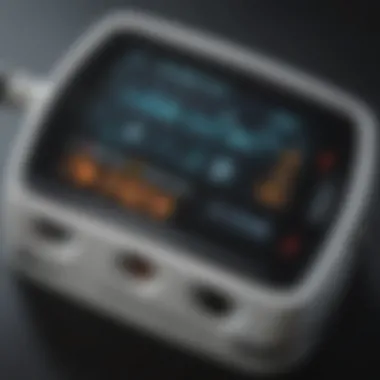
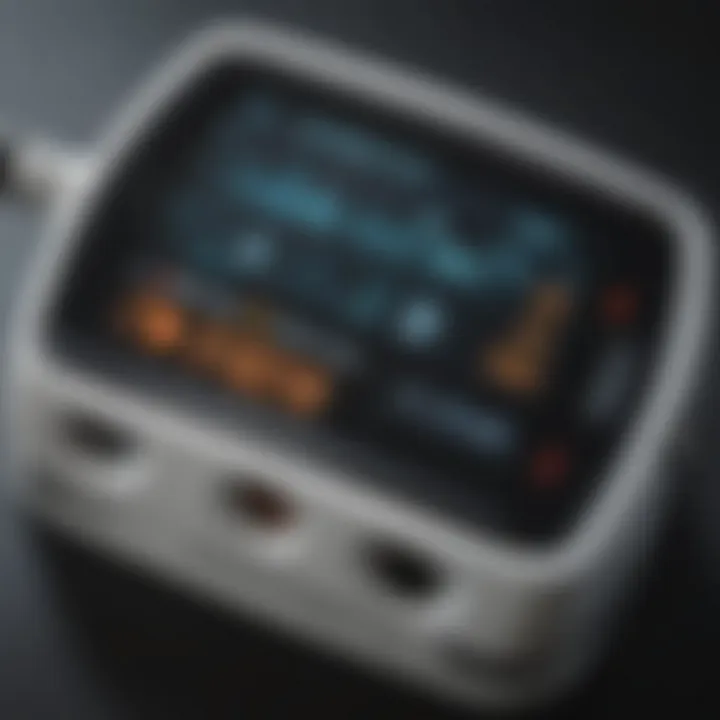
Article Overview
Summary of Key Findings
Healthy individuals typically have pulse oximeter readings ranging from 95% to 100% oxygen saturation. Any reading below this threshold may indicate insufficient oxygen levels in the body. This can be caused by various factors, including altitude, health conditions, and even the positioning of the sensor. The technology behind pulse oximetry is reliable, yet understanding how external variables can affect readings is fundamental for accurate interpretation.
Research Objectives
The primary goal of this article is to provide an extensive understanding of pulse oximeter readings. Readers will gain insights into:
- The standards set for healthy oxygen saturation levels.
- Factors that can cause variability in readings.
- The technology employed in pulse oximetry, and its application in healthcare.
- How to accurately interpret readings and understand their implications for health.
Key Results and Discussions
Main Findings
Research has shown that numerous demographic and physiological factors can influence pulse oximeter readings. For example:
- Age: Elderly individuals may present different baseline oxygen levels compared to younger adults.
- Skin Tone: People with darker skin pigmentation may experience inaccuracies in readings.
- Health Conditions: Conditions such as COPD or asthma significantly affect oxygen saturation levels.
Implications of Findings
The implications of these findings are important for effective patient care. Healthcare professionals must consider a patient’s unique circumstances when evaluating pulse oximeter results. Relying solely on the numbers can lead to misinterpretation of an individual’s health status.
"A pulse oximeter reading is just one piece of the overall health puzzle; contextual factors must be considered for effective assessment."
Intro to Pulse Oximetry
Pulse oximetry is a non-invasive method used to measure the oxygen saturation in a person's blood. This technology has many important applications in both clinical and home settings, providing valuable feedback on a patient's respiratory status. Understanding pulse oximetry is essential in modern medicine, particularly for healthcare providers, educators, and those studying human physiology. The ability to monitor oxygen levels can be critical in emergency situations and for managing chronic respiratory diseases.
The significance of pulse oximeters lies in their role in detecting potential health issues. By observing changes in readings, healthcare professionals can assess if a patient requires further testing or immediate attention. Additionally, these devices are widely used in various practices, from pediatrics to anesthesiology, underscoring their versatility and importance across multiple medical disciplines.
Definition of Pulse Oximeter
A pulse oximeter is a small, clip-like device that attaches to a fingertip or earlobe. Using light sensors, it emits wavelengths of light through the skin to measure how much oxygen is present in the blood. The basic output is a percentage, referred to as SpO2, which indicates the amount of oxygen saturation. Normal SpO2 levels typically range from 95% to 100% for healthy adults. If the readings fall below this range, it can signal a medical issue, warranting further examination.
History and Development
The development of pulse oximetry can be traced back to the late 20th century when researchers sought to create a non-invasive method for measuring blood oxygenation. The first commercial pulse oximeters appeared in the 1980s. These early devices were large and not user-friendly. However, advancements in technology, including miniaturization and digital displays, have made them more accessible and reliable. Today, pulse oximeters are ubiquitous in hospitals, clinics, and homes, illustrating their established role in contemporary healthcare.
How Pulse Oximeters Work
Pulse oximeters are essential devices used in various medical settings to monitor a patient's oxygen saturation levels. Understanding how they work is crucial for interpreting the readings effectively, which is particularly important for healthcare professionals, researchers, and students studying pulse oximetry. This section delves into the basic principles of operation and the components that make these devices function, offering insights into their significance in clinical practice and patient care.
Basic Principles of Operation
The operation of pulse oximeters is based on the principles of light absorption. Each pulse oximeter has a light-emitting diode (LED) that emits light at two different wavelengths: one in the red spectrum and one in the infrared spectrum. As this light passes through the skin, blood, and tissues, it is absorbed to varying degrees by oxygenated and deoxygenated hemoglobin.
The device measures the amount of light that is transmitted through the tissues and calculates the ratio of absorbed light at these two wavelengths.
- Oxygenated Hemoglobin absorbs more infrared light.
- Deoxygenated Hemoglobin absorbs more red light.
By analyzing this information, the pulse oximeter can determine the percentage of oxygen saturation in the blood. Typically, a reading of 95% to 100% is considered normal, indicating that the blood is adequately oxygenated.
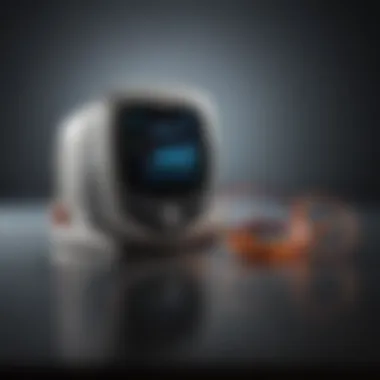
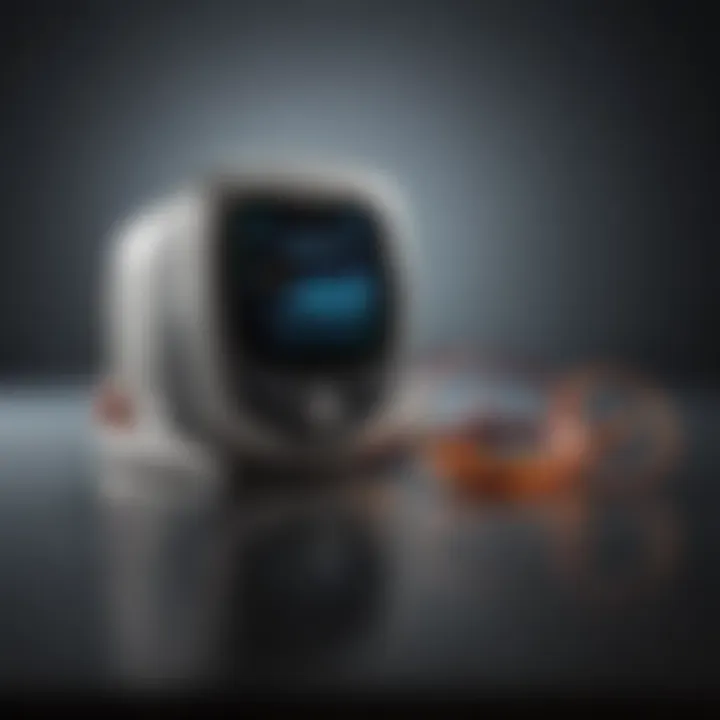
Components of a Pulse Oximeter
The components of a pulse oximeter play a fundamental role in its ability to provide accurate readings. Understanding the main parts can help in appreciating its functionality:
- LED Light Sources: These are responsible for emitting light at specific wavelengths.
- Photodetector: This component receives the light that passes through the tissue and measures its intensity.
- Microprocessor: It processes the data collected from the photodetector to calculate the oxygen saturation levels.
- Display Screen: This shows the readings in an easy-to-read format, allowing for quick interpretation by medical personnel.
"The effectiveness of a pulse oximeter relies not only on the technology but also on how well it is applied in practice."
This combination of components ensures that pulse oximeters can provide timely and accurate assessments of a patient's oxygen status, making them indispensable in healthcare settings.
Understanding Healthy Readings
The benefits of grasping healthy readings extend beyond the clinical environment. For individuals monitoring their own health, awareness of what a healthy oxygen saturation level looks like offers peace of mind. It empowers patients to take charge of their wellness and make informed decisions regarding when to seek professional help. Ultimately, improving public knowledge about pulse oximeter usage can lead to better health management across diverse populations.
Standard Oxygen Saturation Levels
Normal oxygen saturation levels typically range from 95% to 100%. This range indicates sufficient oxygen in the bloodstream, which is essential for optimal body function. A reading below 90% often signals hypoxemia, a condition indicating inadequate oxygen delivery to tissues. Clinicians often reference these thresholds when assessing a patient’s respiratory function.
Factors such as baseline health, physical activity, and altitude can influence these standard levels. For instance, athletes may maintain higher levels due to increased cardiovascular fitness. Similarly, those living at high altitudes may adapt over time, demonstrating lower saturation levels yet remaining healthy. Minor variations, therefore, are worth considering within the context of an individual’s broader health profile.
Several pulse oximeters provide notifications when readings fall below the established threshold, reinforcing the importance of regular monitoring. This feature aids in early detection of respiratory distress and interventions to rectify potentially life-threatening situations.
Factors Affecting Readings
Several factors can affect pulse oximeter readings, making it essential to consider context when interpreting results.
- Peripheral Circulation: Poor blood flow resulting from conditions like heart disease or shock can lead to inaccurate readings.
- Skin Color: Studies indicate that darker skin tones may impact the accuracy of some pulse oximeters due to their design. This nuance underscores the need for ongoing evaluation of health technologies and their performance across diverse populations.
- Movement: Movement during the measurement process can create errors in readings, leading to false conclusions about oxygen saturation. It is important for individuals to remain still while measuring their oxygen levels for the most accurate results.
- Environmental Factors: Excessive ambient light can interfere with the light sensors in pulse oximeters. It is advisable to use the device in controlled lighting conditions whenever possible.
Interpreting Pulse Oximeter Readings
Interpreting pulse oximeter readings is essential for understanding a person's respiratory health. These readings provide valuable insights into oxygen saturation levels, which are crucial for evaluating overall health conditions. Accurate interpretation helps identify potential medical issues early, allowing for timely intervention.
Understanding what constitutes a healthy reading is the foundation of effective interpretation. This knowledge can empower individuals to monitor their health and seek medical attention when necessary. The benefits of accurate interpretation extend beyond personal health—medical professionals rely on this data to make informed decisions about patient care.
In this section, we will explore two key components of interpreting pulse oximeter readings: what a healthy reading is and the indicators that could signify potential health problems.
What Constitutes a Healthy Reading
A healthy pulse oximeter reading usually falls between 95% and 100% saturation of oxygen in the blood. Values in this range indicate that the body's tissues are receiving adequate oxygen. But it's not just the number that matters; it's about understanding the context.
Factors influencing these readings include:
- Age: Younger individuals may have slightly different normal ranges.
- Altitude: Higher altitudes can lead to lower saturation levels.
- Health Conditions: Conditions like COPD or asthma can restrict optimal oxygen levels.
It is also vital to understand that some individuals, particularly those with chronic respiratory issues, might have a baseline oxygen saturation level below 95% without necessarily indicating an acute problem. Thus, if a person's reading consistently falls within the normal range for them, it can be considered healthy.
Indicators of Potential Issues
Lower readings call for careful consideration. Generally, a reading below 90% indicates that a person might be experiencing hypoxemia, which requires immediate medical attention. However, it’s crucial to look for accompanying symptoms like:
- Shortness of breath
- Rapid heartbeat
- Confusion or altered mental state
Not all abnormal readings require panic. The following are common indicators that necessitate further investigation:
- Transient Drops: If oxygen levels recover quickly after a drop, it might not indicate a serious issue.
- Consistent Low Readings: This may point to underlying health conditions that need management or monitoring.
- Technical Errors: Factors like poor sensor placement can affect readings. Ensure the device is positioned correctly for accurate results.
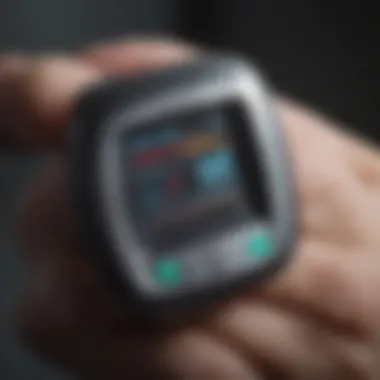
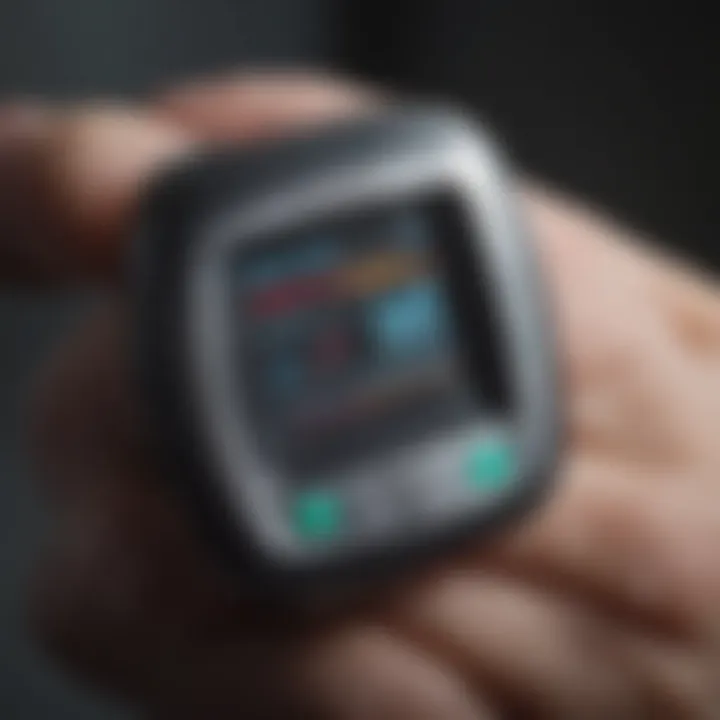
Overall, meticulous interpretation of pulse oximeter readings is vital. A comprehensive understanding can guide individuals in recognizing changes in their health status. Following up on concerning readings with healthcare professionals can facilitate early detection and management of potential issues.
Demographic Variations in Readings
Understanding the demographic variations in pulse oximeter readings is essential since it can help tailor healthcare practices to specific populations. The individual characteristics, such as age and ethnicity, can significantly impact how oxygen saturation levels are measured and interpreted. Recognizing these variations is critical for accurate assessment in clinical settings. Such knowledge encourages better patient outcomes and informs healthcare professionals about potential adjustments required when interpreting readings for different populations.
Age and Oxygen Saturation Levels
Age plays a crucial role in determining healthy oxygen saturation levels. Children and adults can present different baseline readings. For example, infants often have higher oxygen saturation levels, typically ranging from 95% to 100%. In contrast, adults may exhibit normal values from 94% to 98%.
Changes in respiratory function and overall physiological adaptations throughout a person’s life also influence readings. Older adults may experience a decline in lung function. Therefore, their oxygen saturation can be affected, sometimes leading to lower readings even when they are not in distress.
"Understanding how age influences oxygen saturation levels can provide insights into patient monitoring and interventions, which are vital in geriatric care."
Impact of Ethnicity on Readings
Ethnic backgrounds can also influence pulse oximeter measurements. Studies indicate that certain ethnic groups may have variations in hemoglobin levels or skin pigmentation, which can affect the device's accuracy. For instance, individuals with darker skin tones might present more challenges in accurately gauging oxygen saturations with a standard pulse oximeter.
Healthcare providers should be aware of these nuances. This awareness helps in choosing the right methods for monitoring cognitive health in various populations. Having a comprehensive understanding of how ethnicity can influence pulse oximetry readings is essential for providing equitable care to diverse communities.
In summary, demographic variations in pulse oximeter readings underscore the importance of tailoring healthcare practices to be inclusive and precise. By acknowledging the influences of age and ethnicity, healthcare professionals can enhance their monitoring strategies for better health outcomes.
Common Misconceptions
Understanding pulse oximeter readings plays a crucial role in modern healthcare, especially in the context of oxygen saturation assessment. The importance of addressing common misconceptions cannot be overstated. These misconceptions can lead to confusion about what pulse oximetry measures and how its readings should be interpreted. This section aims to clarify prevalent misunderstandings, contributing to better use and comprehension of pulse oximetry in clinical and personal settings.
Pulse Oximetry and COVID-19
The COVID-19 pandemic brought pulse oximeters into the limelight. Many people turned to these devices to monitor their oxygen levels at home. Some believed that a pulse oximeter could determine the severity of COVID-19. It is essential to correct this notion. While a pulse oximeter can indicate oxygen saturation, it does not measure the underlying cause of low levels, whether due to COVID-19 or something else. Dependence solely on this device for diagnosing or assessing COVID-19 severity can be misleading.
In many cases, individuals with COVID-19 may maintain oxygen levels within a normal range while experiencing significant respiratory distress. It's critical for patients to seek professional advice if they have symptoms, even if their pulse oximeter indicates a healthy reading. Relying on home monitoring without clinical input can delay necessary medical interventions.
Debunking Myths about Oxygen Levels
Several widespread myths exist regarding oxygen levels and their significance. One common myth is that a reading of 95% oxygen saturation is always ideal. While levels above 95% are generally considered healthy, some individuals may function perfectly well with lower readings, especially if they have chronic respiratory conditions. Thus, a generalized standard for "normal" oxygen levels does not apply universally.
Another misconception is that pulse oximeters are entirely reliable. In reality, various factors can affect the accuracy of readings, including poor circulation, nail polish, and skin pigmentation.
To clarify further, here are several points to consider regarding oxygen levels:
- Individual Variability: Everyone has different baselines for oxygen saturation.
- Context Matters: Always consider physical condition and environmental factors.
- Health Factors: Chronic lung diseases or cardiovascular issues may influence desired oxygen levels.
Clinical Applications of Pulse Oximetry
Pulse oximetry plays a crucial role in various clinical environments. Understanding its applications is essential for both healthcare professionals and patients. The technology provides immediate results regarding a patient’s oxygen saturation levels, which is vital in making informed medical decisions.
Monitoring Patients with Respiratory Issues
Monitoring patients with respiratory conditions is one of the primary applications of pulse oximetry. Chronic conditions like chronic obstructive pulmonary disease (COPD), asthma, and pneumonia often lead to fluctuating oxygen levels. Regular monitoring can help caregivers detect any deterioration in the patient’s condition. The non-invasive nature of pulse oximeters makes them suitable for frequent use, allowing for continuous assessment without causing distress.
In these scenarios, accuracy is paramount. If a patient’s oxygen saturation levels drop below the recommended range of 95% to 100%, it may signal worsening respiratory function. This can prompt further diagnostic tests or interventions such as oxygen therapy. Therefore, healthcare providers must be adept at interpreting these readings within the context of each patient's medical history and current condition.
Use in Emergency Settings
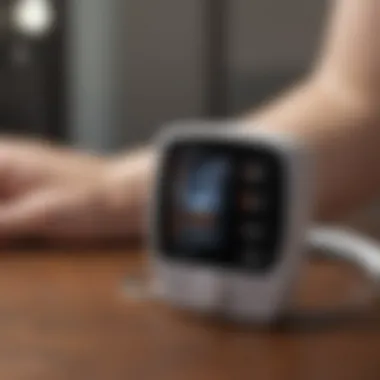
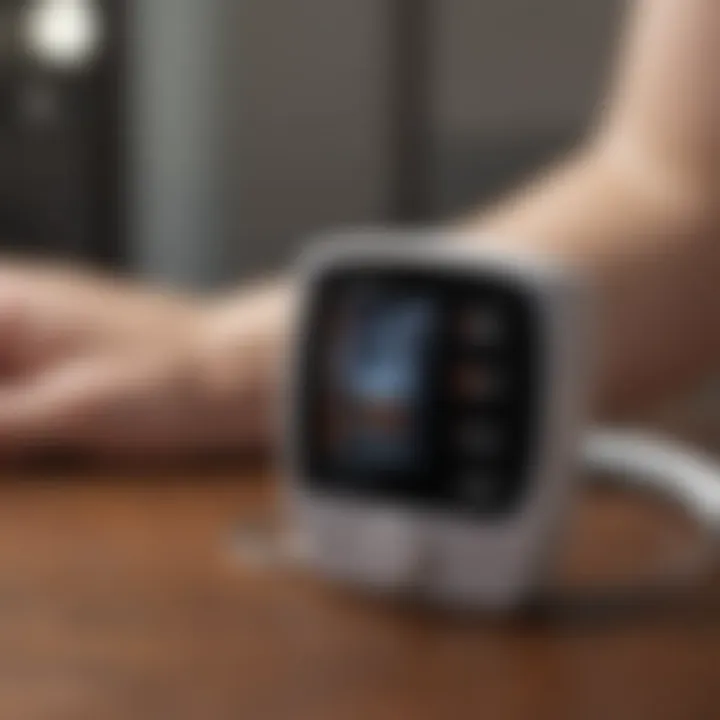
Pulse oximetry is also indispensable in emergency medical situations. First responders rely on this technology to quickly assess a patient’s oxygen saturation levels upon arrival at the scene. This immediate feedback aids in determining the severity of the situation and prioritizes resources effectively. It also becomes a critical part of the data collected during transport to a medical facility.
In emergency settings, time is of the essence. A pulse oximeter provides fast and reliable readings that can guide interventions such as intubation or administering supplemental oxygen. Its importance cannot be overstated when seconds count, and every decision must be based on accurate, real-time data.
"Effective pulse oximetry in emergency care not only saves lives but enhances the overall efficiency of the healthcare response team."
In summary, understanding the clinical applications of pulse oximetry is vital for professionals in healthcare. Monitoring patients with respiratory issues ensures timely interventions, and its use in emergencies can significantly influence patient outcomes. As technology continues to evolve, the role of pulse oximeters in clinical practice will likely expand further.
Limitations of Pulse Oximetry
Understanding the limitations of pulse oximetry is crucial for proper interpretation of readings. While pulse oximeters are valuable tools in clinical practice, they are not infallible. Misinterpretation of the data can lead to incorrect conclusions about a patient's respiratory status. Thus, a thorough knowledge of the potential sources of error and when to seek additional testing is essential.
Potential Sources of Error
- Skin Tone: Research indicates that darker skin tones may affect the accuracy of pulse oximeter readings. The sensors might not function equally across different skin pigmentation. This discrepancy may lead to underestimation of true oxygen saturation levels.
- Nail Polish and Artificial Nails: The presence of dark nail polish or artificial nails can interfere with the accuracy of measurements. These materials can block the light wavelength used in the readings, resulting in false values.
- Poor Circulation: Conditions that impair blood flow, such as peripheral vascular disease, can diminish the effectiveness of pulse oximeters. Reduced blood flow means less oxygenated blood is available for measurement, causing readings to be unreliable.
- Movement and Positioning: Movement of the patient or incorrect positioning of the sensor can also skew results. If the user is moving or if the sensor is not securely attached, this can disrupt the reading.
- Environmental Factors: Temperature and altitude can play a role in the readings. High altitudes and cold environments may affect the accuracy, leading to misinterpretations of oxygen saturation levels.
It's important to correct for these potential errors in order to make informed clinical decisions.
When to Seek Additional Testing
Certain situations warrant further evaluation beyond basic pulse oximeter readings. Healthcare professionals should consider additional tests if:
- Readings are Unusually Low: If the pulse oximeter indicates an oxygen saturation level below 90%, further testing is vital. This level can indicate hypoxemia, necessitating additional assessment.
- Symptoms Persist: A patient presenting with symptoms such as shortness of breath, even with normal readings, may require further examination to rule out underlying conditions.
- Discrepancies with Clinical Signs: If there is a clear contradiction between the patient’s clinical presentation and the pulse oximeter readings, further tests such as arterial blood gas (ABG) analysis should be conducted.
- Chronic Health Conditions: Patients with underlying respiratory issues like COPD or asthma may require routine monitoring and evaluation beyond what a pulse oximeter can provide.
In summary, while pulse oximetry has improved patient monitoring in many ways, it’s vital to understand its limitations. Recognizing when to utilize additional testing can provide a more accurate picture of a patient's respiratory health.
Future Trends in Pulse Oximetry
The area of pulse oximetry is rapidly evolving due to advancements in technology and ongoing research. Understanding future trends in this field is essential for comprehension of how pulse oximeters will enhance medical practices. As healthcare continues to innovate, pulse oximeters are becoming more accurate, accessible, and integral to patient care. This section will outline the key advancements anticipated in technology and research directions that could significantly impact how we monitor oxygen saturation levels.
Advancements in Technology
In recent years, the pulse oximeter has undergone substantial improvement. New technologies are making these devices smarter and more user-friendly. For instance, wearable technology has been a game-changer. Devices like smartwatches can now monitor blood oxygen levels in real-time, providing a convenient tool for both patients and healthcare professionals.
Other advancements involve enhanced sensors that offer increased precision. These sensors are more reliable in diverse conditions, making it easier to obtain accurate readings regardless of the patient's environment or movement. The integration of artificial intelligence and machine learning into pulse oximetry platforms is gaining traction. These tools can analyze vast sets of data, helping in identifying patterns and predicting complications.
Moreover, wireless connectivity is enabling seamless data transfer between devices and medical records. This facilitates quicker decision-making and enhances remote patient monitoring abilities. In settings where immediate access to healthcare professionals is limited, these advancements can be critical.
Research Directions and Innovations
Current research investigates the effectiveness of pulse oximetry in a variety of clinical scenarios. There is a growing interest in understanding how pulse oximeters can be applied beyond traditional boundaries. For example, studies are exploring their utility in sports medicine, where monitoring oxygen levels can assist athletes in performance optimization and recovery.
Additionally, innovations are are being pursued in the material sciences to create sensors that are less intrusive and more comfortable for long-term use. The potential for non-invasive sensors that can measure gases other than oxygen — such as carbon dioxide — is also being explored. This could significantly broaden the scope of respiratory monitoring.
Furthermore, the intersection of telemedicine and pulse oximetry is a prominent research area. Developing user-friendly applications that allow patients to self-monitor at home could improve healthcare access and self-management.
"As pulse oximetry technology advances, its role in healthcare will become increasingly critical.”
In summary, the future trends in pulse oximetry focus on technological advancements that improve accuracy and accessibility, plus research that expands the clinical applications of these devices. Keeping abreast of these developments can enhance the understanding and effectiveness of pulse oximetry in modern healthcare.
End
In this article, we have explored the significance of standard oxygen saturation levels, recognizing that readings below 90% can indicate serious health issues. Moreover, demographic variations in oxygen saturation must not be overlooked, as these can affect how readings are interpreted. With increasing reliance on pulse oximeters in both clinical and home settings, being informed about their capabilities and limitations is paramount.
Summary of Key Points
- Understanding Oxygen Saturation: Normal oxygen saturation typically ranges from 95% to 100%. Readings below this level necessitate further investigation.
- Factors Influencing Readings: Conditions such as altitude, skin color, and underlying health issues can affect pulse oximeter accuracy.
- Demographic Considerations: Age and ethnicity genuinely play roles in expected oxygen saturation levels, impacting clinical assessments.
- Importance of Knowing Limitations: Recognizing potential sources of error can inform better usage and interpretation of pulse oximeter readings.
Final Thoughts on Pulse Oximetry
Pulse oximetry has evolved as a cornerstone in modern health monitoring. Given the accuracy and convenience of devices available today, it is vital to recognize both the advantages and limitations of pulse oximeter technology. While they are effective tools for preliminary assessments, a comprehensive understanding is needed for any health-related conclusions.







